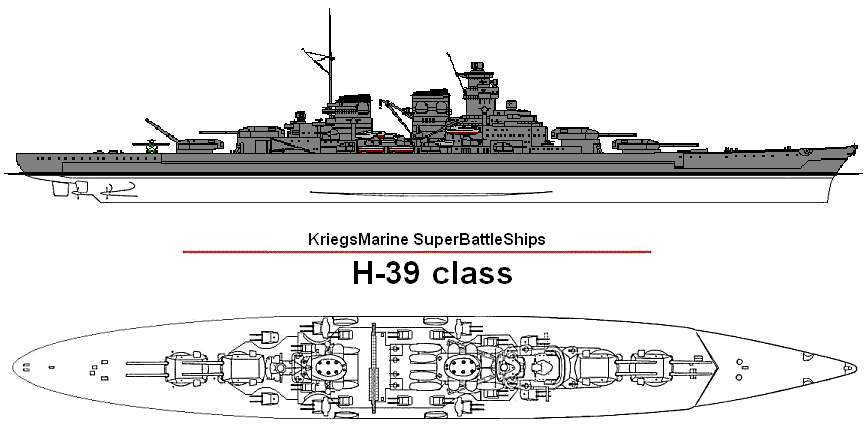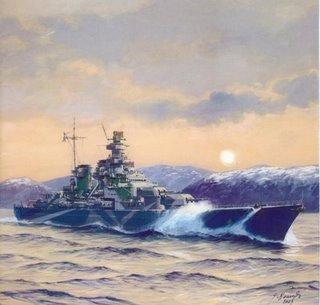Schlachtschiff H-39 : 
Kreigsmarine BattleShips - H-39 Class ==========================================================================

Hull Laid down by Blohm & Voss Hamburg, 15.07.1939 ..... incomplete ship scrapped 25.11.1941
The H-Class ships saw their design finalized by 1939, intended to be the mainstay of Kriegsmarine's Plan Z. The Z-Plan was Nazi Germany’s fleet building program started shortly before World War II.
The H-39 design was a type of battleship proposed by Nazi Germany before the outbreak of World War II. They essentially represented an enlarged and refined Bismarck class, armed with 40.6 cm guns, revised armour configurations, and diesel machinery. Six ships were contemplated, all to be commissioned by 1944, which in turn necessitated that construction begin in 1939. However, by the 10th of October 1939, construction (which had only commenced on the first two vessels) was halted to make room for expansion of the U-Boat fleet, as the onset of the World War II undid the Kriegsmarine's prewar strategy.
In the mid 1930s, a major discussion about a new fleet program started in Germany. There were two major options of what kind of program should be chosen. One plan was focused on a large submarine fleet and a relatively small surface fleet for coastal protection (this plan was preferred by the U-Boot faction in the Kriegsmarine command) while the other was a mixed fleet of various surface ships and a much smaller U-Boot fleet, quite similar to the Imperial Navy in World War I or the British Royal Navy. In the end, the latter plan was chosen as the new fleet building program, after several modifications it was called the "Z-Plan".
According to this plan, the German Kriegsmarine would have grown to about 800 units, consisting of 13 battleships and battle cruisers, 4 aircraft carriers, 15 Panzerschiffe, 23 cruisers and 22 so-called "Spähkreuzer" which were basically large destroyers. In addition, many smaller vessels would have also been built.
Those ships would have been built between 1939 and 1946; in this time, the personnel strength of the Kriegsmarine should have been enlarged to 201,000 men and over 33 billion Reichsmarks should have been spent for construction of the new units.
However, these ambitious projects never were realized. It is questionable whether the German industry would have had the resources for such a monumental construction program and that the other European nations would have just stood still and not react to this program.
The realization of the Z-Plan started on January 29th, 1939. Two H-Class battleships were laid down yet three months later Germany quit the fleet treaty with Britain and the propaganda dream of "No more war against Britain" was gone.
Four months later, Germany openly attacked Poland and work on all Z-Plan projects was stopped. During the next months, all incomplete ships of the Z-plan were scrapped and the material was used to build additional submarines.
The prior F - G design, a 35,000-ton battleship program started in 1932, was laid down before the Anglo-German Naval Treaty of 1935. These would become the Bismarck class, the largest battleships built by Germany, and the heaviest battleships in any European navy. Despite this they had a number of design flaws, which the admirals of the Kriegsmarine were determined to correct in their next design, the H class. In 1937, Germany's Oberkommando der Kriegsmarine (OKM) ordered a study for a new battleship class to succeed the Bismarck design.
From the beginning Adolf Hitler insisted on 50.8 cm (20.0 in) guns, instead of a 40.6 cm (16.0 in) caliber. The naval staff had difficulties in persuading him that any design mounting guns larger than 16 in was not practical. Any battleship which mounted 20 in guns would have to weigh 80,000-120,000 tons, with a length of 1,000 ft (300 m). This would also mean reconstructing German ports so as to service such a ship. Additionally a German 16 in gun design had already been developed in conjunction with the 38.0 cm (15.0 in) design. Any new design for a much larger gun would dramatically lengthen the design and construction process. Finally Hitler agreed with the H-39 design as proposed.
The H-39 class design was basically an enlarged version of the Bismarck class. The most noticeable difference was the use of two smokestacks on the H-39 class, instead of one on Bismarck. The Bismarck also used steam turbines for propulsion, while the H-39 class was designed for diesel engines, and had a 60% increase in operating range over the earlier ships. The twelve propulsion diesels would also provide a top speed of 30 kn (56 km/h), about the same performance as the battleships in other navies. The space requirements for the engines and stacks also prevented a hangar/catapult arrangement amidships as in Bismarck. The hangars for four Arado Ar 196 floatplanes were placed in the aft superstructure with rails running on either side of the aft turrets to a centerline catapult aft of turret D.
The H-class ships would have compared more favorably than the Bismarck class to other battleships of the time, being superior to the older design in both armament and armor. They would have out-classed every British battleship afloat. However, the proposed British Lion class battleships, armed with nine 16 in (406 mm) guns would likely have outgunned them, and sporting an extra 85 mm of belt armor (380 mm), would have enjoyed greater protection than the H-class.
In 1938 OKM developed Plan Z which would enlarge the Kriegsmarine by 1945. Part of this called required a total of six H class battleships to be laid down. In August Hitler ordered that the Bismarck class be completed by late 1940 and that the construction of the H class would begin in 1939. In January 1939 the Plan Z was adopted and the order for the six H class battleships was placed.
Schlachtschiff "H" (Friedrich der Grosse) was laid down on July 15, 1939 and Schlachtschiff "J" (Grossdeutschland) on September 1, 1939. "K" was scheduled to be laid down on September 15 but this was postponed because of the outbreak of World War II. A hold was also placed on construction of the two ships already started. At the time that construction was frozen "H" had 14,055-tons of material ordered, 5,800-tons delivered but only 766-tons worked into the keel. There had been less work on the "J". 3,531-tons of material had been ordered but only 40-tons put into the keel.

After the loss of the battleship Bismarck, the requirements for a new battleship were defined by the Kriegsmarine construction office. Based on the original H-39 design, the result was a battleship besign based on four main requirements:
* Strong horizontal armor protection
* top speed of at least 30 knots
* main artillery best fitting to the ship size
* good protection against mine hits
There was no given limit in the ship displacement and the ship was about the same size as the Japanese Yamato class. Compared to previous designs the ship had thicker horizontal armor protection. To achieve the required speed, a mixed diesel / steam turbine engine system was chosen.
For the first time, it was planned to equip the battleship with an armored hull bottom to defend the ship against mine hits.
During 1941 the "H class" was redesigned ("H-41") and it was proposed to bore out the existing guns to 42 cm (16.5 in) caliber. One of the reasons behind this conversion was to give these ships a larger caliber weapon than those planned for any known Allied battleship. This and the later "H-42" never got off the drawing board. Then in late 1943, Hitler's original idea of a huge 50.8 cm (20.0 in) gunned battleship was drawn up. This was designated "H-44", but with the stress on German war production at a high level it was decided by late 1944 to abandon the project. The assembled steel was later used to make U-boats.
While only ten of the four-dozen main gun barrels needed for the H-39 ships were completed, without the ships it was decided to use the guns constructed for coastal artillery. Four guns were emplaced at Battery Trondenes outside Harstad, Norway. A twin battery was built on the island of Engeløy further south, as Batterie Dietl. Three guns were set up in Hel near Danzig, as Battery Schleswig Holstein. After extensive testing the guns were transported from Hel to Sangatte, France and set up as Battery Lindemann, from where they fired across the English Channel at Dover. Today, the Adolf Gun at Battery Trondenes is open as a museum during the summer season.
Even though the H class was never completed the first ship in the class, Friedrich der Grosse remains a part of naval fiction. Several alternate history books have been written using Friedrich der Grosse, and she has appeared in several naval wargames as well.
During World War II itself Time Magazine featured several articles in 1940 and 1942 about German capital ships. Friedrich der Grosse is mentioned as one of these ships.

=================================================================================
NB: The above text has been collected / excerpted / edited / mangled / tangled / re-compiled / etc ... from the following online sources :
KM - H-39 Class BattleShip - wikipedia article #1
KM - Schlachtschiff H-39 - www.german-navy.de
KM - H class SuperBattleShips ... H39-H44 (1939-1946) - strangevehicles.greyfalcon.us


